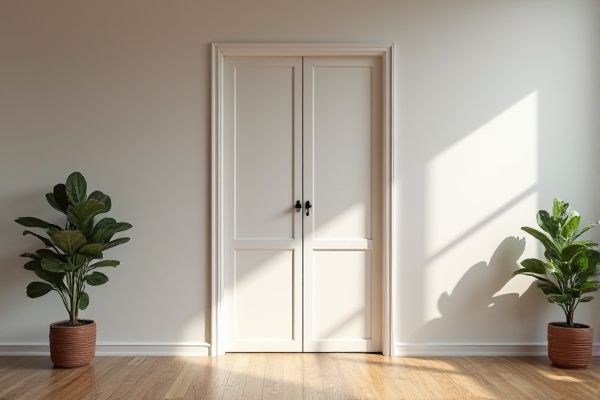
Sliding door closets maximize space efficiency by gliding along tracks, making them ideal for rooms with limited floor area, while hinged door closets offer full access to the interior but require clearance for door swing. Explore the advantages and drawbacks of each to determine which closet style best suits your space and lifestyle.
Table of Comparison
| Feature | Sliding Door Closet | Hinged Door Closet |
|---|---|---|
| Space Efficiency | Ideal for small rooms; doors slide parallel to closet | Requires clearance for door swing; needs more floor space |
| Accessibility | Can access half the closet at a time | Full access to the entire closet when doors are open |
| Installation Complexity | Requires track system; may need professional installation | Simple hinges; easier DIY installation |
| Maintenance | Tracks can collect dust, may need regular cleaning | Hinges need occasional tightening or lubrication |
| Design Variety | Modern, sleek look; available in glass, mirrors, wood | Classic look; wide range of styles and materials |
| Durability | Sliding mechanism may wear out over time | Hinges generally durable with proper care |
| Cost | Typically higher due to hardware and installation | Usually more affordable and budget-friendly |
Introduction to Closet Door Types
Sliding door closets feature doors that glide horizontally along tracks, saving space and providing a sleek, modern look ideal for compact rooms. Hinged door closets open outward on hinges, offering full access to the entire closet interior without track limitations, which can be beneficial for larger spaces. Your choice between sliding and hinged doors depends on room size, accessibility needs, and aesthetic preferences.
Overview: Sliding Door Closets
Sliding door closets maximize space efficiency by gliding smoothly along tracks, making them ideal for rooms with limited clearance. Their streamlined design offers a modern aesthetic and allows easy access without obstructing room flow. You benefit from enhanced storage organization while maintaining clean, unobtrusive interior style.
Overview: Hinged Door Closets
Hinged door closets feature doors attached to the frame with visible side hinges, allowing the doors to swing outward fully and provide easy access to the entire interior space. These closets generally require more room clearance for door opening, making them ideal for larger bedrooms or areas with sufficient space. Your choice between hinged and sliding door closets depends on your room layout and access preferences, as hinged doors offer unobstructed entry but need more wall clearance.
Space Efficiency Comparison
Sliding door closets maximize space efficiency by eliminating the need for door clearance, making them ideal for small rooms or tight spaces. Hinged door closets require additional space to open, which can limit room layout options and reduce available floor area. For compact environments, sliding doors offer a more practical solution by allowing full access without obstructing surrounding areas.
Aesthetic and Style Considerations
Sliding door closets offer a sleek, modern aesthetic that maximizes space and provides a streamlined look ideal for contemporary interiors. Hinged door closets present a classic and versatile style, allowing full access to the wardrobe and showcasing detailed door designs that enhance traditional or elegant room decor. The choice between sliding and hinged doors significantly impacts the visual flow and functional appeal of the closet area.
Accessibility and Convenience
Sliding door closets offer enhanced accessibility in tight spaces by gliding open without requiring extra clearance, making them ideal for small rooms or narrow hallways. Hinged door closets provide full access to the entire closet interior when open, allowing easier reach to items without obstruction. Convenience is higher with sliding doors in compact areas, while hinged doors facilitate broader visibility and easier organization in spacious rooms.
Durability and Maintenance
Sliding door closets feature durable tracks and rollers designed for smooth operation, but these components require regular cleaning and occasional lubrication to prevent wear and ensure longevity. Hinged door closets typically have sturdier door frames and hinges with fewer moving parts, resulting in lower maintenance demands and a longer lifespan under normal use. Both types benefit from quality materials like solid wood or metal hardware to enhance durability and reduce long-term upkeep.
Cost and Installation Differences
Sliding door closets typically cost more upfront due to their complex track systems and require precise installation to ensure smooth operation. Hinged door closets generally have lower material and installation costs, with simpler hardware and easier mounting on standard door frames. Your choice impacts budget and labor time, making hinged doors more cost-effective for quick installations while sliding doors suit spaces where saving room is a priority.
Best Use Cases for Each Closet Door
Sliding door closets are ideal for small rooms or spaces with limited clearance since they do not require extra room to open and allow easy access to the entire closet with a single slide. Hinged door closets work best in larger spaces or walk-in closets where a full view of the interior is needed at once, providing unobstructed access and the ability to hang hooks or organizers on the door's back. For homes with tight hallways or narrow bedroom layouts, sliding doors maximize floor space, while hinged doors suit master bedrooms or storage rooms where wide access and ease of installation are priorities.
Conclusion: Choosing the Right Closet Door
Sliding door closets save space by gliding smoothly along tracks, making them ideal for small rooms or tight areas, while hinged door closets provide full access to the entire wardrobe at once, enhancing ease of use. Consider your room layout and frequency of closet access to determine whether the space efficiency of sliding doors or the accessibility of hinged doors suits your lifestyle best. Your choice between sliding and hinged closet doors should balance functionality, space constraints, and style preferences for an optimal storage solution.
 homyna.com
homyna.com